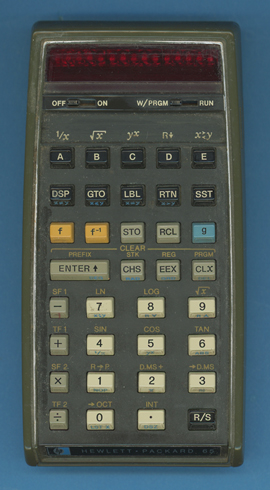
DATAMATH CALCULATOR MUSEUM
 |
DATAMATH CALCULATOR MUSEUM |
Hewlett-Packard HP-65
| Date of introduction: | January 19, 1974 | Display technology: | LED |
| New price: | $795 (MSRP 1974) | Display size: | 10 + 2 |
| Size: | 5.9" x 3.2" x 1.40" 151 x 81 x 36 mm3 |
||
| Weight: | 10.9 ounces, 308 grams | Serial No: | 1333A23534 |
| Batteries: | HP-82001A (3*NiCd AA-size) | Date of manufacture: | wk 33 year 1973 |
| AC-Adapter: | HP-82002 | Origin of manufacture: | USA |
| Precision: | 10 | Integrated circuits: | HP65-CPU, Mostek MK6111, MK6112, MK6113 |
| Logic: | RPN | ||
| Memories: | 9 | ||
| Program steps: | 100 | Courtesy of: | Ken H. Meine |

![]() Hewlett-Packard
introduced on January 19, 1974 with the HP-65 the World's first Pocket Programmable
Calculator. A marvel of engineering at its time, the HP-65 accommodates in a housing only slightly larger than the
legendary
HP-35 a card
reader for its tiny magnetic strips to archive programs. Users could store programs
with up
to 100 steps on the cards or buy pre-programmed cards from either Hewlett
Packard or third party companies.
Hewlett-Packard
introduced on January 19, 1974 with the HP-65 the World's first Pocket Programmable
Calculator. A marvel of engineering at its time, the HP-65 accommodates in a housing only slightly larger than the
legendary
HP-35 a card
reader for its tiny magnetic strips to archive programs. Users could store programs
with up
to 100 steps on the cards or buy pre-programmed cards from either Hewlett
Packard or third party companies.
The HP-65 was replaced after 2 years with the HP-67 featuring 224 merged program steps and 26 memories instead of 100 partially merged program steps and 9 memories. Compare these specifications with both the Texas Instruments SR-56 and SR-52 programmable calculators.
The HP-65 uses the Reverse Polish Notation with the [ENTER] key instead the usual [=] key and takes the responsibility for:
|
• The Death of the Slide Rule • The never ending Rivalry between TI and HP calculators users • The cat and mouse game leading to products like the HP-67 or TI-59 |

 Dismantling
the featured HP-65 with
Date code 1333A
manufactured in August 1973 by
Hewlett Packard in the United States reveals a very solid design centered around
a Hewlett Packard proprietary CPU (Central Processing Unit) with multiple
Integrated Circuits (ICs) mounted in a ceramic package and supported by three
MK611X ROMs (Read-only Memories) with a capacity of 1,024*10 Bits, each and
manufactured by US semiconductor company Mostek. Please notice the Date codes on
these chips, they were manufactured between week 10 and week 32 in the year 1974
- an obvious sign for some update of the microprogramming of the HP-65.
Dismantling
the featured HP-65 with
Date code 1333A
manufactured in August 1973 by
Hewlett Packard in the United States reveals a very solid design centered around
a Hewlett Packard proprietary CPU (Central Processing Unit) with multiple
Integrated Circuits (ICs) mounted in a ceramic package and supported by three
MK611X ROMs (Read-only Memories) with a capacity of 1,024*10 Bits, each and
manufactured by US semiconductor company Mostek. Please notice the Date codes on
these chips, they were manufactured between week 10 and week 32 in the year 1974
- an obvious sign for some update of the microprogramming of the HP-65.
Learn more about Mostek
Calculator Integrated Circuits.
Milestones of HP calculators
Hewlett-Packard (HP) introduced in 1968 the World's first desktop scientific calculator, the HP 9100A. The programmable calculator stores programs on magnetic cards and lets scientists perform complex calculations without the need to access much larger computers. It is 10 times faster than most machines at solving science and engineering problems. Advertisements for the 9100A call the device a "personal computer," one of the first documented uses of the term.
Only 4 years later, on January 4, 1972, HP makes another advance in personal computing with the HP-35, the World's first scientific handheld calculator. Small enough to fit into a shirt pocket, the powerful HP-35 makes the engineer's slide rule obsolete. With the HP-80 a similar business model was introduced in February 1, 1973. In May of 1973 the HP-45 followed before the first programmable model HP-65 was introduced in January 19, 1974 with a retail price of $795. The HP-70 was introduced in August 1974 to complement the HP-80 as lower end business calculator and it took another few months till the introduction of the HP-55 in January 1975, the last calculator in Hewlett-Packard's series of "First Generation Handheld Calculators". Early in the year 1975 the price tag of the HP-35 dropped to $195 and the calculator was discontinued soon after with the introduction of its successor HP-21, a member of the "Second Generation Handheld Calculators". The introduction of the HP-31E in May 1978 together with its siblings HP-33E and HP-38E marked with the "Third Generation of Handheld Calculators" the end of HP calculators with LED Displays before introducing the revolutionary HP-41C with its alphanumeric LC-Display in July 1979 and the everlasting HP-12C and its sibling HP-11C in September 1981.
In the year 1975 dozens of companies manufactured calculators with 4 functions
and a selling price below $20, scientific and business calculators in the
range around $100 and programmable calculators priced about $250. The slide rule
was outdated and famous companies like Dennert & Pape (ARISTO), A.W.
Faber-Castell and Keuffel & Esser stopped the production.
If you have additions to the above article please email: joerg@datamath.org.
© Joerg Woerner, May 3, 2002. No reprints without written permission.